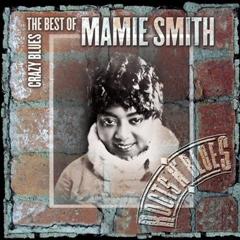Mamie Smith - Crazy Blues The Best Of Mamie Smith (2004)
Mamie Smith - Crazy Blues The Best Of Mamie Smith (2004)

01. Crazy Blues 78rpm Version (With Her Jazz Hounds) (3:18) 02. It's Right Here For You (With Her Jazz Hounds) (2:50) 03. Don't Care Blues (With Her Jazz Hounds) (2:56) 04. Frankie Blues (With Her Jazz Hounds) (2:56) 05. 'U' Need Some Lovin' Blues (With Her Jazz Hounds) (2:54) 06. A-Wearin' Away The Blues (With Her Jazz Band) (3:07) 07. Down Home Blues (With Her Jazz Band) (3:01) 08. The Wang Wang Blues (With Her Jazz Band) (3:06) 09. Wabash Blues (With Her Jazz Hounds) (3:04) 10. Mean Daddy Blues (With Her Jazz Hounds) (2:54) 11. Dem Knock-Out Blues (With Her Jazz Hounds) (2:44) 12. Arkansas Blues (With Her Jazz Hounds) (3:05) 13. Mamie Smith Blues (With Her Jazz Hounds) (3:12) 14. That Da Da Strain (With Her Jazz Hounds) (2:48) 15. I Ain't Gonna Give Nobody None O' This Jelly Roll (With Her Jazz Hounds) (3:03) 16. Mean Man (With Her Jazz Hounds) (2:56) 17. The Darktown Flappers' Ball (With Her Jazz Hounds) (2:54) 18. Kansas City Man Blues 78rpm Version (With The Harlem Trio) (3:17) 19. Do It Mr. So-And-So (3:06) 20. The Lure Of The South (2:46) 21. Golfing Papa (2:43) 22. Miss Jenny's Ball (aka There'll Be No Freebies At Miss Jenny's Ball) (3:10) 23. My Sportin' Man (2:57) 24. Don't You Advertise Your Man (3:14) 25. Keep A Song In Your Soul (2:47) Mamie Smith (vocals) Johnny Dunn (cornet) Willie 'The Lion' Smith (piano) Dope Andrews (trombone) Ernest Elliott (clarinet, tenor sax) Leroy Parker (violin)
Simply put, this is the most extensive collection of Mamie Smith sides on one disc that is available in 2004. It goes much farther than the Classic Blues Essential disc. Between the years 1920-1931 when recording for OKeh, Mamie Smith & Her Jazz Hounds were kindred spirits to Louis Armstrong's Hot Five and Seven, though her sound is far more indicative of the music of the Harlem Renaissance than New Orleans. Sophisticated, hard-swinging, and full of the lilt of cabaret music as well as the down-home roughhouse blues, Mamie Smith had to be the first female blues superstar. This is elegant from top to bottom and offers new acquaintances a view of the blues far from its country origins and tightly woven with jazz. Amazing. ---Thom Jurek, allmusic.com
Mamie Smith was the first to record blues songs in 1920 with her versions of Perry Bradford's "Crazy Blues", and "It' s Right Here for You" on Okeh Records. The record was a wild success, selling over a million copies in less than a year, and finally ending up selling over two million copies. After this it dawned on record companies that there was a lot of money to be made selling what was then called "race records" to various minority groups in big cities.
The success of "Crazy Blues" prompted other record companies to also try to find other female blues singers that could match the sales of "Crazy Blues". It was a very important record, because it opened the doors of the recording industry to African-Americans, whether they were Blues, Jazz or popular singers or musicians. Smith herself really wasn't that much of a Blues singer. She was more of a vaudeville performer, although she included Blues and Jazz numbers as part of her act. She got her start as a dancer at age ten in the vaudeville act the Four Dancing Mitchells and later toured with them as part of the Salem Tutt Whitney and Homer Tutt's show, "The Smart Set". Mamie moved to New York in 1913 with "The Smart Set" and decided that she wanted to stay and quit the show. She strated performing as a singer in Harlem at venues such as Baron Wilkin's Little Savoy Club, Leroy's, Edmunds, Percy Brown's and Banks' Place. Her first recordings were made in early 1920. They were a couple of pop songs "That Thing Called Love" and "You Can't Keep a Good Man Down". They sold well enough and her manager Perry Bradford convinced Okeh Records that there was a market for earthier Blues records aimed at the large number of African-Americans who had migrated to the big cities of the north. Bradford put together a band he called the Jazz Hounds for Smith that was led at first by cornetist Johnny Dunn and then by Bubber Miley. Smith put on quite a show that included trapeze acts, dancing, comedy, lavish costumes and jewelry as well as music. While on tour in 1921 she heard a young Coleman Hawkins playing saxophone in a theatre pit orchestra. Smith asked Hawkins to joined the band, but his family refused to allow him to, because he was just sixteen years old at the time. On her next swing through town in 1922 they onced again asked permission of the family and this time they acquiesced. Hawkins was soon given billing as "Saxophone Boy" and was a popular part of the act. Smith continued to record for Okeh until 1923. In the 1930s and early 1940s Mamie Smith continued to lead a successful career singing and recording as well as appearing in several films. Mamie set the standard for female blues singers that followed in her foot steps. Nearly every other Classic Blues singer of the 1920s borrowed something from her act or styled themselves to achieve her success. --- redhotjazz.com
download (mp3 @320 kbs):
yandex mediafire uloz.to solidfiles global.files workupload
Zmieniony (Wtorek, 27 Kwiecień 2021 18:52)








